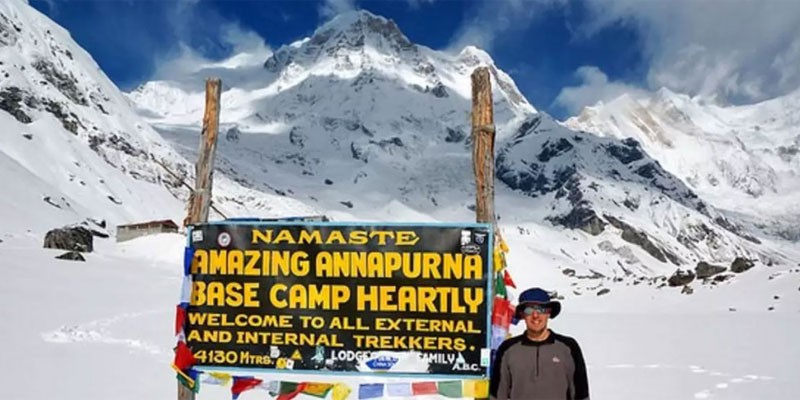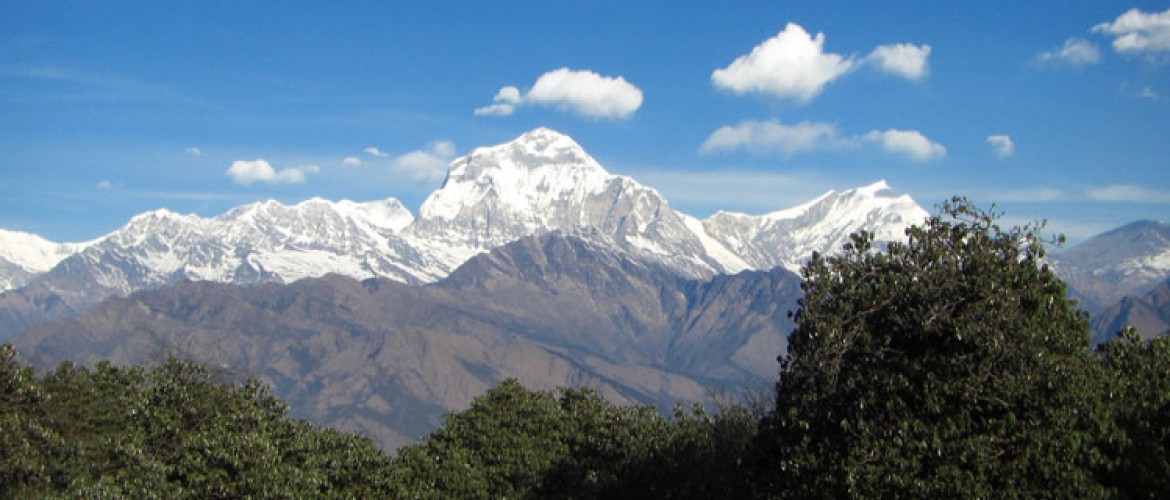
Annapurna Base Camp Trek is one of the most popular treks in Annapurna region. The trip takes you to the base of the world’s 10th highest mountain Mt. Annapurna (8091m). This classic trek offers you the best experiences of the naturally diverse landscape and culturally rich villages of Annapurna region. During the trek, you will witness the glamorous views of Mt. Machhapuchhre, Mt. Annapurna, Mt. Dhaulagiri, Tilicho Peak, Hiunchuli Peak and Pisang Peak. This beautiful trek starts from Pokhara, a wonderful city gifted with natural beauty. The trek is perfect to experience the unique landscape, panoramic mountain views, ancient monasteries & gompas, terraced fields and waterfalls and rich culture of Gurung people. You can also enjoy the unique Himalayan flora and fauna of Annapurna Conservation Area with the best views of snowcapped Himalayas. You will find the various species of flora like pine, rhododendrons, fir and orchids and fauna like leopard, musk deer, langur monkey, reptiles and unique birds.
If you are interested to be a part of this wonderful Himalayan adventure, here are some important things that you need to know about Annapurna Base Camp Trek.

Annapurna Base Camp Trek Itinerary:
Day 01: Arrival Day in Kathmandu
Day 02: Drive from Kathmandu to Pokhara – 6/7 hrs
Day 03: Drive from Pokhara to Nayapul (Trekking starting point) & Trek to Tikhedhunga (1540m) – 5/6 hrs
Day 04: Trek from Tikhedhunga to Ghorepani (2800m) – 5/6 hrs
Day 05: Morning- Hike to Poon Hill (3210m) for Sunrise View & Trek to Tadapani (2650m) at Afternoon – 6/7 hrs
Day 06: Trek from Tadapani to Chhomrong (1950m) – 5/6 hrs
Day 07: Trek from Chhomrong to Dovan (2900m) – 6/7 hrs
Day 08: Trek from Dovan- Machhapuchre Base Camp (MBC) (3700m) – 4/5 hrs
Day 09: Trek from MBC to Annapurna Base Camp (ABC) (4130m) –1/2 hrs
Day 10: Morning Explore ABC- Annapurna Base Camp (ABC) to Bamboo (2300m) – 5/6 hrs
Day 11: Trek from Bamboo to Jhinu Danda (1780m) – 5/6 hrs
Day 12: Trek from Jhinu Danda to Kyumi & Drive to Pokhara (823m) – 5/6 hrs
Day 13: Drive from Pokhara to Kathmandu (210kms) – 5/6 hrs
Day 14: Final Departure from Kathmandu
Best season to visit Annapurna Base Camp
Annapurna Base Camp Trek is possible throughout the year but the most beautiful season to experience the ABC is during Spring and Autumn. These seasons are the best time period to explore the beauty of Annapurna region. In the spring season, the weather is warm and you will witness rhododendron blooms in different colors. The temperature is stable and normal and the sky is clear. The average daytime temperature is about 17 degree and morning and evening don’t go below zero degree. In the autumn season, the weather is dry and moderate. You will get the best visibility and best views of mountains. Days are milder with average temperature of 17 degree and morning and nights are chiller around zero and sub zero temperature.
Annapurna Base Camp Permit
To trek in Nepal, you will need a TIMS card and Permit. In order to trek to Annapurna Base Camp, you need to have TIMs card and permit from the Annapurna Conservation Area project (ACAP).
You need to take permits and TIMs card from Nepal Tourism Board, Kathmandu.
Guide and porters
Trekking trail in mountain region is not so easy. The trail is narrow and confusing sometimes. So, while trekking you need to take Guide and Porters so that you can get proper guidance and good food & drinks and accommodation. Guide and Porters are well trained and experienced.
Guide will provide you the information about trek and safety measures. They arrange food and accommodation, permit and TIMs card for you. They will also help you to make your local experience easy and more meaningful. Porters will help you to carry your luggage. So, with the help of Guides and Porters, you can have a safe and stress-free travel.
Food and water
Food and water are essential needs. While trekking, you need a plenty of nutritious food. In ABC trek, food and water is not a problem as you can find numerous teahouses on the trail that provide healthy and nutritious food. Most of the time, the menu is basic.
Breakfast: egg, oatmeal, corn flakes, toast, Tibetan bread, pancakes, muesli and hot drinks.
Lunch/Dinner: rice, lentil and curry, soup, thenduk, noodles, thukpa, pasta, salad, rotis, momos, pizza etc.
In every trekking, you need to hydrate yourself with at least 4-5 liters of water per day. Lodges and tea houses on the trail will provide you clean drinking water. To avoid plastic bottles, bring your own bottle and refill it. You can also carry water purification tablets.
Accommodation
Annapurna Base Camp Trek is a popular trek so you can find accommodation easily. In lower altitude you will get lodges with more facilities and in upper altitude you will get tea houses with basic facilities. The rooms and facilities are limited compared to cities area. Most of the time you have to share rooms (twin sharing). There are enough lodges and tea houses in Annapurna region but sometimes during peak season, it can be difficult to get rooms. In that case, you have to be prepared to use common rooms.
Communication
Both NTC and NCELL networks are available in Annapurna region but communication can be unstable during the trek. Sometime you get the network & sometimes you don’t (especially when you are in higher altitudes). In the lodges and teahouses in lower altitude, you will also get the wifi. You have to pay some extra charges for the service. But in higher altitude, communication can be challenging. So, it’s better to get rental satellite phone if communication is really important for you.
Electricity
During the trek to Annapurna Base Camp, electricity is available at teahouses and lodges where you will spend your night. In lower altitudes, electricity is not a problem. In higher altitude, you can charge your phone, laptops, camera from solar panels at teahouses by paying some extra charges. But it’s always a good idea if you carry your power bank.
Clothing and gear/equipment
It is essential to carry good clothes and gears/equipments while trekking. Sometimes packing too less and too more many causes a problem in your trek. So, make a list of the clothes and gear/equipment you want to take on the trek with you. Normally, it includes trekking bags, upper body wears (T-shirts, thermal vest, lightweight thermal tops, waterproof jackets, fleece jackets or pullover, women sports bra and synthetic), lower body wears (hiking sorts, fleece pants, waterproof shell pants, undergarments, lightweight walking pants), trekking shoes, thick socks, essential gears (sleeping bag, trekking pole, sunscreen, waters bottles, water purifiers, head torch, first aid kit, hand sanitizers, towel, wet wipes, toiletries) etc.
Difficulty Level
ABC trek is moderate-difficult grade. The trail is full of switchbacks. In a day you have to walk for 6/7 hrs. The trail is well-marked. Since, it doesn’t go beyond 4130 m, you don’t need any skill and experience. But you need to be physically fit and used to outdoor adventures. Prior Himalayan exposure is an advantage.